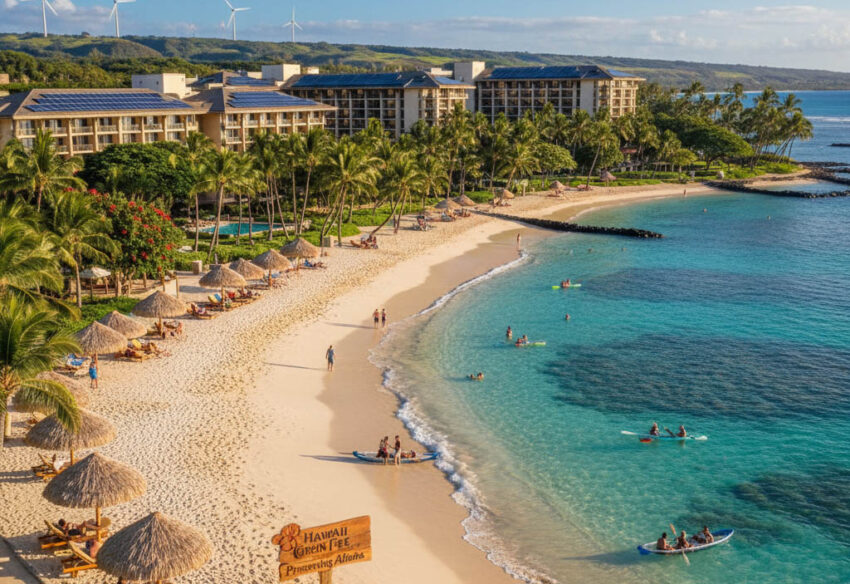
Hawaii Joins Florida, Texas, Alabama, Connecticut, Georgia in Imposing Hotel and Tourism Tax, What is New in This

Hawaii has joined Florida, Texas, Alabama, Connecticut, and Georgia in imposing hotel and tourism taxes, marking a significant shift in how states utilize tourism revenue. While these states have long relied on hotel taxes as a primary source of funding for infrastructure and tourism promotion, Hawaii’s recent introduction of new measures is noteworthy. The state has introduced the “Green Fee,” which adds an additional 0.75% to its existing tourism tax. This new tax is aimed at funding climate resilience projects, further integrating tourism revenue with environmental sustainability efforts. Like Florida, Texas, Alabama, Connecticut, and Georgia, Hawaii’s move signals a broader trend of adjusting hotel and tourism taxes to meet both economic and environmental needs. As these states impose or update their hotel and tourism taxes, they are prioritising not only tourism growth but also the protection and preservation of their natural resources for future generations.
In recent years, several US states have been using tourism and hotel taxes as important sources of income. These taxes, typically levied on hotel rooms and other accommodation services, play a crucial role in local economies. They not only help promote tourism but also fund critical infrastructure, environmental initiatives, and social services. As the demand for more sustainable and impactful uses of these taxes grows, states are increasingly adjusting and introducing new tax structures.
Among the states leading the charge is Hawaii, where recent legislation is setting a new precedent in tourism tax use. Hawaii’s move to direct tourism tax revenue towards climate change projects is just one example of how these funds can be used for the public good, rather than solely for tourism promotion.
The Basics of Tourism and Hotel Taxes
Tourism and hotel taxes are taxes imposed on individuals who stay at hotels, motels, resorts, or other accommodation facilities. These taxes are typically charged as a percentage of the cost of the room and vary from state to state and city to city. In many cases, the tax revenue is used to fund tourism promotion activities or to maintain local infrastructure that benefits both residents and visitors.
For example, in New York City, the combined hotel tax rate can exceed 14%, made up of both state and local taxes. Similarly, in California, local governments often implement hotel taxes with rates varying from city to city. In San Francisco, the hotel tax can go up to 16.25%, helping to fund city services and tourism-related expenses.
These taxes have become essential for many local governments to provide the necessary public services and infrastructure required to support growing tourist numbers. However, in some states, tourism tax rates have also been adapted to support other sectors, particularly environmental initiatives.
Hawaii: Leading the Charge with a Tourism Tax for Sustainability
Hawaii has recently taken a bold step in how it uses tourism-related taxes. In May 2025, Hawaii introduced the Green Fee, a new tourism tax designed to fund climate resilience and environmental projects across the islands. The Green Fee is an additional 0.75% added to the state’s existing Transient Accommodations Tax (TAT), which already stands at 10.25%.
Governor Josh Green supported this initiative, believing that it would help Hawaii tackle the challenges posed by climate change. This new law is expected to generate an additional $100 million annually, which will be used for projects like restoring beaches, enhancing infrastructure to protect against hurricanes, and removing invasive species of plants that increase wildfire risks. This innovative tax marks the first time in the U.S. that tourism revenue has been directly tied to climate change mitigation efforts.
This move comes at a time when states are increasingly looking for ways to use the revenue from tourism taxes for long-term sustainability rather than simply increasing short-term tourism numbers. Hawaii’s Green Fee is seen as a model for other states, showing that it’s possible to balance tourism growth with environmental protection.
The Impact of Hawaii’s Green Fee
The introduction of the Green Fee is a reflection of Hawaii’s commitment to sustainability. With its beautiful beaches, coral reefs, and rich biodiversity, Hawaii’s economy is closely tied to its natural resources. However, these resources are also under threat from rising sea levels, hurricanes, and invasive species.
By using tourism tax revenue to address these environmental issues, Hawaii is not only protecting its environment but also ensuring the long-term viability of its tourism industry. The Green Fee will fund essential climate change projects, helping to restore damaged ecosystems, strengthen hurricane protection systems, and ensure that Hawaii remains a sought-after destination for tourists.
Additionally, this new tax is an example of how states can leverage tourism taxes for broader social and environmental goals. Other states can follow Hawaii’s lead and create similar funding mechanisms to tackle environmental challenges in their own regions.
Other States and Localities Adjusting Hotel Taxes
While Hawaii’s Green Fee is a groundbreaking step, it is not the only state to adjust its tourism and hotel taxes in recent years. Other states have also implemented or modified their tax rates to address local economic needs and promote sustainable tourism.
For instance, in Florida, the state has increased its hotel tax rate to fund tourism infrastructure projects. The revenue generated is used to improve local roads, enhance public transportation systems, and support state-run tourism campaigns. Similarly, Texas has raised hotel taxes in Austin to fund cultural projects, such as preserving historic landmarks and promoting arts events that attract tourists.
Local governments have also been creative in how they use hotel tax revenue. In Chicago, the city imposes a hotel tax of up to 17.4% and directs the funds to tourism promotion and the development of local parks and recreational areas. Similarly, in Los Angeles, the combined state and local hotel tax rate exceeds 15%, with the funds allocated to support public services such as public transportation and city clean-up projects.
These examples show how local and state governments are adapting tourism tax structures to meet the unique needs of their communities, whether it’s funding infrastructure, supporting cultural projects, or promoting tourism in a sustainable way.
Tourism Taxes for Sustainable Development
The trend of using tourism tax revenue for sustainable development is growing across the United States. States and local governments are increasingly recognizing that tourism taxes are not just a source of revenue for short-term benefits, but a powerful tool for long-term economic and environmental sustainability.
In cities like Denver, Colorado, and Portland, Oregon, tourism taxes are being used to fund initiatives aimed at reducing carbon emissions, increasing renewable energy use, and promoting eco-friendly tourism practices. These taxes also support projects that improve the sustainability of local infrastructure, such as energy-efficient hotels, eco-friendly public transportation, and waste reduction programs.
Using tourism taxes for sustainability is a win-win: it helps communities address the immediate needs of their tourism industries while ensuring that the natural and social resources tourists come to enjoy are protected for future generations. This approach aligns tourism growth with environmental stewardship and social responsibility, making it more appealing to eco-conscious travelers.
The Future of Tourism and Hotel Taxes
Looking ahead, the future of tourism and hotel taxes in the United States will likely see even more states and local governments using these taxes for broader goals. As climate change continues to pose a threat to ecosystems and communities, more states may adopt policies similar to Hawaii’s Green Fee, directing tourism taxes toward climate resilience and sustainability projects.
Furthermore, as tourism grows in popularity, cities and states may continue to raise hotel tax rates to keep up with the demands of their infrastructure and services. The challenge will be finding a balance between generating revenue and ensuring that the taxes do not discourage tourists from visiting.
Transparency will be crucial in this process. Tourists and local residents must have a clear understanding of how their tax dollars are being spent, especially when it comes to initiatives like environmental conservation or infrastructure development. If local governments can demonstrate the direct benefits of tourism taxes, tourists will likely be more willing to support these initiatives.
A New Era for Tourism Taxes
Tourism and hotel taxes have long been a staple of the US economy, supporting tourism promotion and local infrastructure. However, states like Hawaii are now taking these taxes a step further by using them to fund essential climate resilience and sustainability projects. The introduction of the Green Fee is a bold and innovative move that sets a new standard for how tourism revenue can be used for the public good.
As more states and localities adjust their tax rates and allocate funds toward long-term goals, the future of tourism taxes looks promising. By linking these taxes to sustainability efforts, governments can ensure that the tourism industry continues to thrive while protecting the natural resources that make these destinations so attractive in the first place.
Other states will likely follow Hawaii’s lead in creating sustainable funding mechanisms that address both the economic and environmental challenges of the 21st century. With careful planning, transparency, and a focus on long-term goals, tourism taxes can become a critical tool for building a more sustainable and resilient future for all.
The Department of Hawaiian Home Lands (DHHL) is looking to tap into Hawaii’s tourism tax revenue to address a long-standing housing crisis for Native Hawaiians. With over 30,000 individuals on a waiting list for homestead lots, DHHL proposes a 1% increase in the Transient Accommodations Tax (TAT) to generate essential funds. This plan could significantly impact the state’s development efforts and provide much-needed relief for Native Hawaiian communities.
DHHL’s Plan to Tap Tourist Tax Revenue
The Hawaiian Home Lands Department is proposing a bold strategy to alleviate its chronic underfunding issues. At the core of the plan is a request to lawmakers for a 1% increase to the Transient Accommodations Tax (TAT), which applies to hotel room rates. The funds generated from this tax would be directed toward home loan assistance and the development of homestead lots for Native Hawaiians, aiming to reduce the growing waitlist for housing. With nearly 30,000 applicants currently waiting for land, this measure is seen as a crucial step in providing the housing relief the community desperately needs.
Potential Impact on State Revenue
If lawmakers approve the TAT increase, the Department of Hawaiian Home Lands anticipates an annual revenue boost of more than $100 million. These funds would primarily support home loan programs and the development of housing for Native Hawaiians. Furthermore, this funding could allow the department to leverage matching federal and state contributions for development projects, amplifying the impact of the proposed tax hike. By directing tourist tax revenue specifically to these projects, DHHL hopes to make a real difference in the lives of thousands waiting for their land.
Environmental Projects Funded by Green Fee
The Green Fee, a new tax set to take effect next year, aims to address climate change and environmental stewardship projects across the state. This tax is set at an additional 0.75% on hotel room rates and is expected to raise $100 million annually. DHHL plans to align some of its funding proposals with this Green Fee law by requesting funding for infrastructure projects that will improve the resilience and sustainability of homestead lands. These projects include wastewater treatment systems, wildfire mitigation measures, and improvements to water systems.
Challenges in Raising the Tourist Tax
While the proposal to raise the TAT is well-intentioned, it faces significant hurdles. Lawmakers, including Rep. Dan Holt, express concerns about the timing of such a tax increase. The tourism industry, still reeling from the effects of the pandemic, may find it difficult to absorb another tax hike so soon after the introduction of the Green Fee. Industry representatives argue that additional tax increases may hurt tourism and hinder Hawaii’s economic recovery. Therefore, lawmakers are also exploring alternative funding solutions, including permanent, sustainable revenue sources for DHHL.
Tourism Industry’s Concerns About Fund Allocation
Opposition from the tourism sector is a major roadblock in the path of the proposed tax increase. Hotel operators have voiced concerns about the transparency and accountability of tourist tax revenue allocation. Specifically, they worry that funds from the TAT, which currently go into the state’s general fund, may not always be directed toward the intended projects. There is also concern about the potential for short-term vacation rentals to underreport their earnings, thereby contributing less to the tourism tax. Despite these concerns, some hotel operators have expressed willingness to support a targeted tax increase if the funds are earmarked for specific initiatives like housing development.
Financial Struggles of DHHL
DHHL has long struggled with inadequate funding, despite the existence of a federal law passed in 1921 to provide land for Native Hawaiians. While the state allocated $600 million to DHHL three years ago to boost development, the department’s financial models suggest it would need billions of dollars to meet the housing demand. The 1% increase in the TAT is seen as a lifeline to help fill this funding gap. However, the department’s proposals also include a series of infrastructure projects, which will require significant financial investment beyond what the TAT increase could provide.
Governor Green’s Support for DHHL Initiatives
Governor Josh Green has expressed support for DHHL’s mission and its funding needs. His office has confirmed that while the governor has not yet reviewed all of the department’s proposals, he has shown consistent backing for initiatives aimed at assisting Native Hawaiian communities. Should DHHL’s proposed funding measures be included in Green’s package of bills next January, it could signal a pivotal moment in addressing the housing crisis in the state. Governor Green’s involvement would help elevate the importance of this issue to both lawmakers and the public.
Plans for Infrastructure and Environmental Stewardship
The DHHL bill includes additional funding requests aimed at improving the infrastructure of homestead lands. These projects range from converting cesspools to modern wastewater treatment systems, to enhancing water systems across the state. Given the state’s commitment to environmental sustainability, these projects would align well with the Green Fee law, which supports climate change mitigation and environmental efforts. By prioritizing infrastructure, DHHL hopes to create self-sustaining communities that can support Native Hawaiians for generations to come.
Future of DHHL’s Funding and Development
While the 1% TAT increase remains a contentious proposal, DHHL’s ongoing efforts to secure alternative funding sources will be crucial in meeting the housing demands of Native Hawaiians. The agency’s plans include not just housing development but also projects aimed at improving the quality of life on homestead lands, such as fire protection and emergency evacuation routes. These projects are vital in ensuring that the future of Native Hawaiian communities is secure and resilient to the challenges posed by climate change and environmental degradation.
Navigating Funding Challenges for Native Hawaiians
The Department of Hawaiian Home Lands is at a crossroads, facing financial struggles that have prevented it from fulfilling its mandate to provide land for Native Hawaiians. The proposed increase in the TAT, while promising, comes with significant opposition from the tourism industry and lawmakers concerned about its potential impact. With nearly 30,000 individuals on the waiting list for housing, the need for immediate solutions is urgent. DHHL’s commitment to seeking new funding sources, including the Green Fee, offers a glimmer of hope, but much work remains to be done to secure the future of Native Hawaiian communities.
The post Hawaii Joins Florida, Texas, Alabama, Connecticut, Georgia in Imposing Hotel and Tourism Tax, What is New in This appeared first on Travel And Tour World.
Hawaii Joins Florida, Texas, Alabama, Connecticut, Georgia in Imposing Hotel and Tourism Tax, What is New in This
| Divisions of Shy Paris Entertainment | ||||
|---|---|---|---|---|
| Shyparis Entertainment | Shy Paris Bookings | Linkz Radio | Klublinks | Shy Paris |
Shy Paris Bookings is a Division of
❤Shy Paris Entertainment ||||| International Spectacular Events, Stellar Event Planning and Management, & Celebrity Booking Agency. Please contact us as we can provide you with both international and/or local renowned full service event planning and management, & celebrity bookings at shyparisentertainment@gmail.com or
CONTACT: Email: shyparisentertainment@gmail.com
Facebook: ShyParis Youtube: @Shyparis Twitter: @Shyparisent Instagram: shyparisentertainment Whatsapp: 1-437-259-3399
✶✶✶✶✶✶✶✶✶✶✶✶✶✶✶✶✶✶✶✶✶✶✶✶✶✶✶✶✶✶✶✶✶✶✶✶✶✶✶✶✶✶✶✶✶✶✶✶✶✶
SHY PARIS ENTERTAINMENT COMPANIES
✅ ShyParisentertainment.co – https://shyparisentertainment.co
✅ Shyparisbookings.com – https://shyparisbookings.com
✅ Linkzradio.com – https://linkzradio.com
✅ Klublinks.com – https://klublinks.com
✅ Shypariswebdesign.com – https://shypariswebdesign.com
✅ ❤️ Shyparis – htttps://shyparis.com❤️







